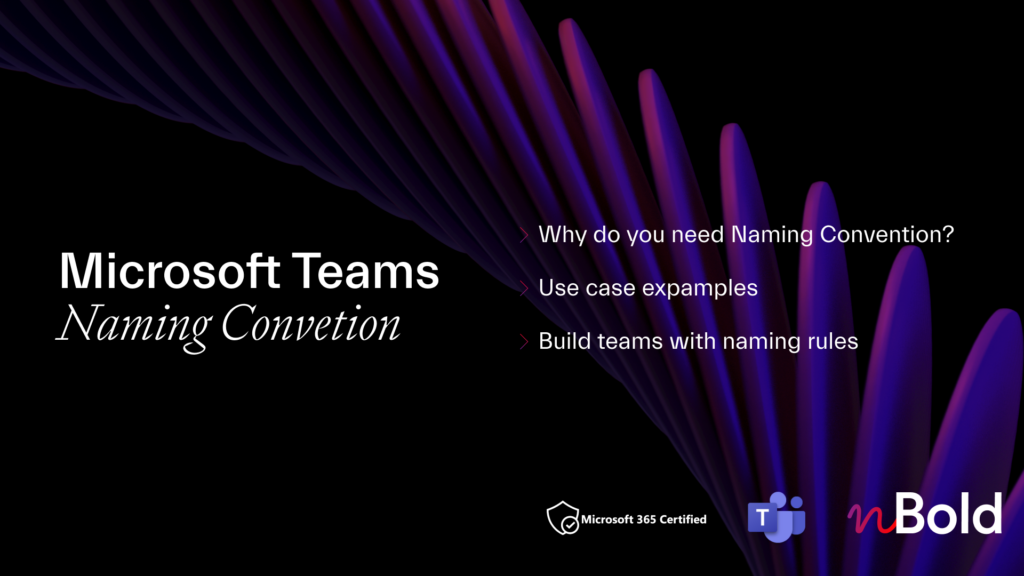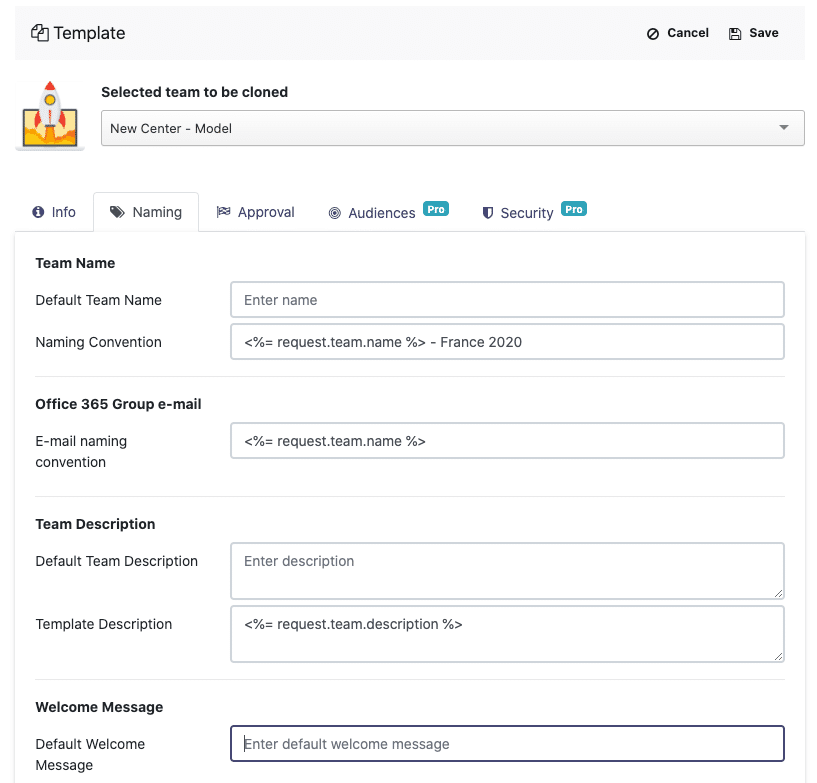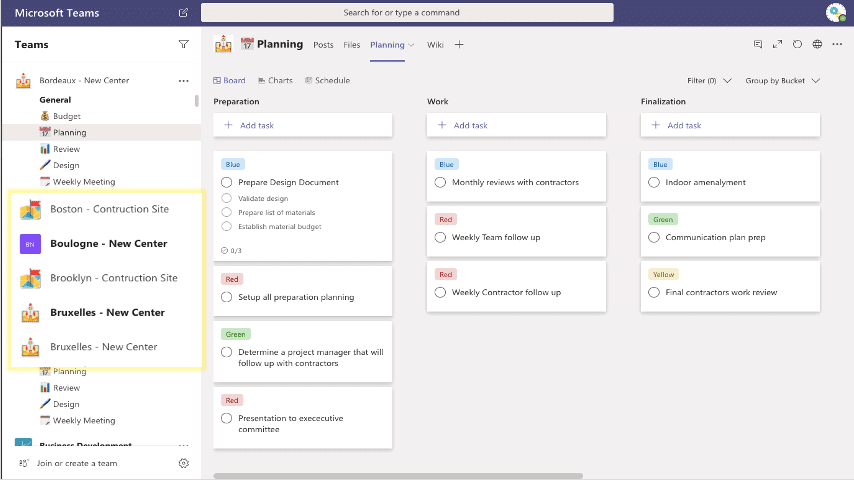A naming convention is a specific agreed algorithm that allows you to name entities in an orderly way. It started with the Romans’ first nomenclature system and a combination of a personal and family name. Today, we meet it everywhere: we know about product naming conventions, we see this system in the scientific field and many other areas. Naming convention has passed centuries before becoming a major element of the Microsoft Teams structure, and its adoption at scale in the organization.
There is no doubt, the implementation of a naming convention in the organizational structure is key when we are talking about successful management and governance. Therefore, let’s talk a bit about the reasons why you should set up naming rules in your organization.

Microsoft Teams naming convention
Microsoft Teams was made to empower teamwork. The platform allows you to create different teams for each of your projects, campaigns, or departments with relevant channels while sharing documentation and tasks, communicating, and working on daily activities together. It encompasses various features such as chat, meetings, app integrations, collaboration with team, document co-authoring, etc.
When thinking of a name for your teams, think of its purpose. Let’s take some real-life examples:
Teams to collaborate at a department level
In a large organization with diverse organizational structure, it can be tricky to understand the level of access or the importance of each team. To make it easier for the users, you can add the name of the department or your business unit to your team name.
These examples are just a few among all the possibilities! The idea here is to take real-life examples to illustrate the importance of a naming convention and how it can defer for one business process to another.
Project management scenario
While creating different teams dedicated to different projects, you would implement a naming convention to understand different departments or geographics.
For example, a naming convention would be:
- With Country: “Name of The Project – Country – Project”
- With Department: “Name of The Project – Department – Project”
Site management scenario
The naming convention is key in the construction or retail industries. When a company is developing and it opens a new retail store, managers can create a team with channels for each new store. Here they should implement a naming system. For example, the team name should include the location of a new store. As a result, this system can simplify the search process for end-users and the IT management.
So a Naming Convention would be for example:
- “City – Site name”
- “City – Country – Site name”
Teams at a department level
The Teams Naming Convention would be key to making sure that it reflects the organizational structure in the same way from one department to another. This is true at a department level as this also applies to any organizational type of a team (at the business unit level, the country level, etc.).
So, a Teams Naming Convention would be, for example:
- “Department Name – Department”
- “Department Name – Department – Country”

If you are in IT, you already know this. Beyond the employee experience, a naming convention is extremely important in the IT sphere, especially for all the IT operations. Applying naming rules would solve many IT management issues, for example Teams sprawl.

White Paper with free Teams Naming Convention examples
- Use Case Examples
- Microsoft Teams naming convention solutions
- Naming Convention at Teams Template Level
- Fixed and Dynamic Naming Convention
Naming rules should go beyond just the team’s name level. The chosen name of the team has so many impacts on the IT side. It defines the Microsoft 365 Group email address; and it defines the SharePoint sites URL that is attached to the team itself. As Microsoft 365 groups are a core component of your company productivity suite, and as SharePoint is gathering potentially several thousands or millions of files in your company, you can imagine how IT needs to create rules and policy to make sure that all the information is compliant, secured, etc. Lack of naming convention results in a nightmare for the IT department, and therefore costs and risks that could be avoided.
Naming convention solutions
After understanding why a Teams naming convention is both valuable and critical in different scenarios, let’s talk about other scenarios related to the Teams Naming Convention Solutions regarding Microsoft Teams.
There are 5 that you can adopt:
- No naming strategy
- Guideline-Based Naming Strategy
- Azure AD Premium Plan
- Forms and Power Automate
- Naming Convention based at the Team Template Level
No naming convention for Microsoft Teams
Of course, you can simply not bother yourself with the creation of a Teams naming system and work without any structure for your Microsoft Teams. This way, your employees can create on their own a flexible naming system.
They can name teams and channels based on their own judgement, goals, and management style. In addition, your documents are named randomly.
However, it will be difficult for your staff to find the right team, channel, or file. It is true for large organizations, but we are convinced that even in small firms and start-ups even a simple naming system can improve work efficiency.
For sure, without implementing a naming convention into your organizational structure your employees feel free to manage a flexible naming system for Microsoft Teams. At the same time, without a naming convention, your productivity could decrease.
You would have no structured documentation folders, and your projects and teams would be named in a chaotic way. As a result, your employees will spend a lot of time finding necessary files and information.
From an IT perspective, it will result in a mess in terms of IT management as described above.
Pros:
- Fully flexible
- Easy experience
Cons:
- Organizational disorder
- No segmentation in the Teams
- Nightmare for IT
- Increase in management costs and risks

Guidelines-based naming convention
Everyone in your company can work and create tons of content in SharePoint, Microsoft 365 group tools, and Microsoft Teams. For naming convention management, you can implement a self-service model based on a standard format. The goal of this process is to report and track purposes properly.
If you plan to implement a naming convention in your organization, a good option for you will be to set up a guidelines-based naming convention. It means that you should define the rules on how each of your content, teams, and projects will be named depending on the business context and then communicate it to users through your corporate guidelines.
Firstly, we recommend you discuss the naming conventions with your team and IT specialists to understand how your workers search for information, how collaborative processes are handled in teams by people and different IT processes.
After understanding what key information is required to quickly identify a file or team, you can write down your own guidelines and communicate with people.
Results:
Your team members will know exactly how they should name a new team, project, and files. As an example, you can see the Harvard University Guidelines on Microsoft 365 Groups, SharePoint Sites, and Teams in this article with simple examples of guideline-based naming conventions. You will see the forms for Department, Multi-Department, and Cross Affiliated Name that is advised to people inside the organization.
Obviously, naming guidelines are a good option to start with. It can be for your daily work with your team and at the organization level.
Hence, your team can simplify the search process and all your important files will be structured. In addition, you don’t need to spend a lot of time and resources on creating and designing the naming process.
At the same time, the naming convention system with guidelines often gives too much freedom for users. As a result, it’s driving inconstancy especially for large organization with different levels of access and privacy.
Pros:
- Fully flexible in terms of guidelines
- Easy adoption and usage
Cons:
- Naming inconsistency
- Not a great option for large organizations with different levels of access
Azure AD Plan 1 naming convention
Of course, Microsoft has its own tools for naming Microsoft 365 groups.
To enforce your naming convention for Microsoft 365 and Microsoft Teams, you should pay attention to Azure Active Directory attributes. With Azure AD you can set up a group naming policy to communicate the function of a team, geographic region, membership, and who created the group. With Azure AD you are able to:
To define blocked words
One good opportunity here is to set up the list of phrases to be blocked in a group name. This way, the user that uses a blocked word in the name of the created team will see an error message. It can be useful to block some words around key themes that you want to control, ban bad language words, or some exec names, etc.
And it’s going beyond Microsoft Teams once setup. You’ll get this feature in all the other Microsoft 365 apps.
Azure AD technology gives you opportunities to improve your naming convention settings. You can automate the naming process for your organization based on your user’s data.

Set up prefix-suffix naming policy
You can add any prefix and suffix to your team or file name. For example, you can use strings to scan and differentiate teams in the global address list. One more option is to use attributes.
It can help your team to identify which office, department, or geographic region was created for which group. With Azure AD attributes you may add a company, department, office, country, or region, and many more based on the user data.
It’s very interesting in theory. However, we’ve never seen a company using it at scale. A naming convention with prefix and suffix does not make any sense in Microsoft Teams and very few companies all over the world have implemented these capabilities.
Here is why:
As Microsoft Teams is not aware of the business context, it creates Prefix and Suffix based on the user profile only, (Azure Active Directory) and it’s not taken into account the business context of the collaboration happening in Teams.
So, let’s imagine you’re a manager in the engineering department. You want to create Teams to organize a new project that is cross-department as you’re working on a new product. What you would like your team to be called is “Name of the New product – Project”.
With Azure AD Premium naming convention, the team’s name would include the department name ” – Engineering”, that actually you don’t want since it’s cross-department. This is one example only but if you take all the different used cases, you’ll see that in many contexts it’s simply not making sense. Not because the feature capability is not good enough.
It’s only because Microsoft can’t be aware of the business scenario behind the team.
The last point that you should keep in mind is that all these features are available only with Azure AD Premium Plan, included in EMS and in Microsoft 365.
Pros:
- Automated naming process
- Imposed to users with AAD attributes
Cons:
- Available only with Premium Plan
- Prefix and suffix without business context do not make sense

Forms and Power Automate
One more interesting scenario for you is to create an automation process with Microsoft Power Automate and Forms or even Power Apps. You can automatically create a new team from Microsoft Power Automate, even with approvals if needed. You’ll find some examples in this video from the Microsoft MVP Dave Kawula or with this open project in GitHub from Correy Buzzell working at Microsoft in the Minneapolis Technology Center.
With Microsoft Power Automate you can build an app where employees will enter all the different information regarding their team requests like Name, Business Unit, Country, etc. You’ll then be able to combine all of that to set up your naming convention for a team name.
You’ll be able to set up an approval in the request process Power Automate. You can add a step where the approver adapts the name if needed and approves the creation.
Therefore, with Microsoft Power Automate you can implement a Form instead of a complete Power App, which triggers a Flow to create a new Team based on the forms data. It’s simpler than building a complete Power App but it offers fewer possibilities.
In each case, here you would need to build all of this and maintain it. This is definitely a possibility that has to be considered when balancing the time spent on building all of this, the cost of maintenance, and the complexity it can bring in terms of user experience.
Pros:
- Ideal alliance with Office 365 capabilities
- Fully Flexible
- The ability to add approval workflows
Cons:
- Complicated usage in terms of end-users
- Difficult system to solve all business issues
Microsoft Teams template-based Naming Convention with nBold
Here we are! Best suited solution 😊. Not only because we’re building it. It’s actually why we’ve built it – to solve all the different issues that you can face today and that we saw before.
At nBold our mission is to make collaborative processes efficient at scale in the organization. And collaboration can’t be scaled, especially with Microsoft Teams, without strong Governance Policies.
nBold offers Collaboration Templates for any business process with pre-built channel structure, file templates, guidelines and all your favorite apps and other content already included. This way, you get ready-to-go teams with everything needed to collaborate efficiently around projects, deals, accounts, campaigns and any other use case.
Explore more Naming Convention examples with available tags 😉
For each template, you can set up different governance policies like Approval, Audience Targeting, Permanent Owners and Members, and Teams Naming Convention Policy.
As mentioned before about the challenges you could face regarding the importance of a Teams Naming Convention depending on the business context, with Teams Templates Governance Policies, it’s solved. You can build a differentiated Naming Convention depending on your business context.
Here is an example of a team Template setup for the naming convention where all the team will be called “Name entered by user – France 2020”

Let’s take some examples for a team name:
- Project Team Template: “Name of the project – Project” or “Name of the project – User Department – Project”
- Construction Site Team Template: “Name of the project – New location” or even add to Team Description the main goals and planned finish date of a project
- Recruitment Team Template: “Name of the Team – Preferred Language”, “HR – Name of the Team”
- Department teams Template: “Name of the Department – Name of the project – Office 365 usage location”
During the creation of a new Template, you can set up not only the team Naming Convention but also the Team Description, the Welcome Message, and the associated Office 365 Group Email Naming Convention. Thus, add related tags to the team description to categorize the purpose (#marketing, #CEO, #Crisis_Management). Also, by adding a short guide about team usage to the welcome message you can simplify your teams adoption.
Naming convention with Collaboration Templates is easy with:
- Fixed Prefix and Suffix for static or Dynamic convention
- Azure AD Attributes to set up a system based on users Data
- Office 365 group email
- JavaScript syntax to open to any possibility
Here is an example of the result of a Naming Convention based on the city for New Center project and Construction Site management:

Check ready to use scenarios for your Microsoft Teams with standard java script operators and functions.
Static Naming Convention for all the Marketing Team teams.
<%= request.team.name %> - Marketing Team Dynamic Naming convention depending on usage location.
<%= request.team.name %> - <%= user.msUsageLocation %> For a conditional team name, use a specific suffix for users from a specific domain, use the domain name for the others.
<%= request.team.name %> - <% if (user.msEmail.includes('@contoso.fr')) { %>CT France // Use "CT France" instead of contoso.fr<% } else { %><%= user.msEmail.replace(/.*@/, '') %> // Extract domain name from user email address<% } %>Teams Description: Add business solution to Team Description.
<%= request.team.description %> - Created from the template <%= request.template.name %>. Created by
Pros:
- Naming Convention Management at the template level for different business and IT needs
- Secure and at the same time simple system in alliance with AAD
Cons:
- Only admins can manage Naming Convention
- The function is able only with nBold Pro (but no worries, you will get tons of additional features)
Learn more about Microsoft Teams Naming Convention by nBold.
In conclusion, naming convention is an extremely important system for your organizational daily activity. With the right naming algorithm, you can simplify your hierarchy system, automate the naming process, and improve work efficiency.
In this article, we described for you different systems you can use to solve your business issues. Now, you should choose the ones that will be ideal for your organization and workers. nBold is here to optimize and address your needs.
Contact our team to learn how to implement the right naming strategy in your organization.
